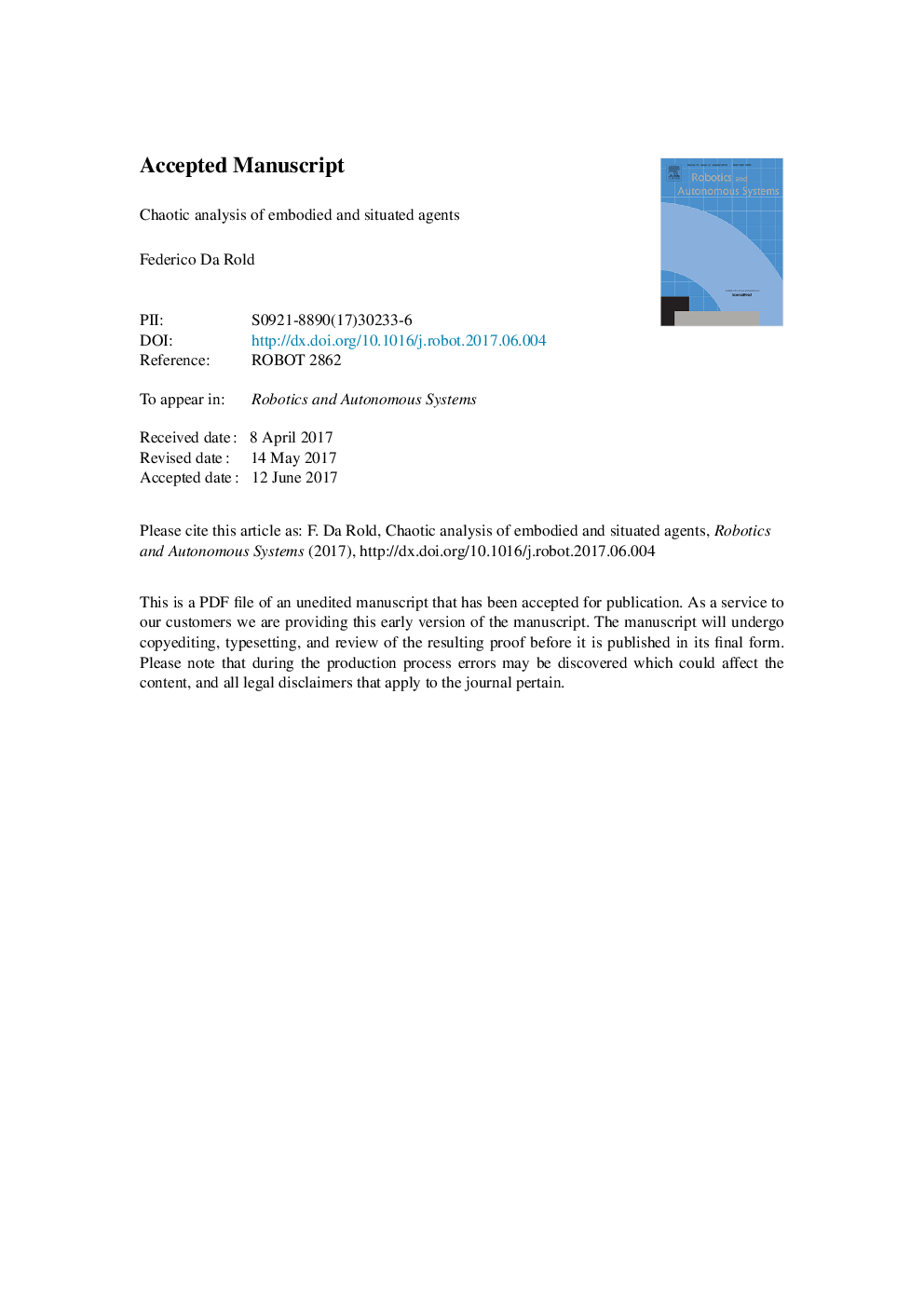| کد مقاله | کد نشریه | سال انتشار | مقاله انگلیسی | نسخه تمام متن |
|---|---|---|---|---|
| 4948670 | 1439847 | 2017 | 56 صفحه PDF | دانلود رایگان |
عنوان انگلیسی مقاله ISI
Chaotic analysis of embodied and situated agents
ترجمه فارسی عنوان
تجزیه و تحلیل هرج و مرج عوامل مؤثر و واقع شده است
دانلود مقاله + سفارش ترجمه
دانلود مقاله ISI انگلیسی
رایگان برای ایرانیان
کلمات کلیدی
شناخت تجمعی، شناختی رباتیک تکاملی نظریه هرج و مرج، تجزیه و تحلیل سری غیر خطی،
ترجمه چکیده
دیدگاه مبهم و مفهوم شناختی یک چارچوب فراشناختی است که بر اهمیت زمان واقعی و تعامل دینامیکی عامل با محیط اطراف تأکید می کند. این مقاله مجموعه ای از آزمایشات تکاملی رباتیک را ارائه می دهد که مفهوم چنین عملی را آموزش می دهد، آموزش مینیاتوری ربات های دو چرخ متحرک به طور خودکار به حل یک کار زمان می پردازد. به منظور ارائه یک توصیف عددی از رفتار روبات، اقدامات هرج و مرج بر روی جذب بازسازی شده از موقعیت های ثبت شده عامل ارزیابی می شود. تئوری هرج و مرج یک چارچوب ریاضی دقیق را مطابق با یک رویکرد ضد انعطاف پذیر ارائه می دهد که برای درک سیستم های ممتاز و مجهز است، در حالی که اجتناب از تجزیه سیستم یکپارچه مغز - بدن - محیط مفید است. سریهای زمانی با استفاده از ابزارهای غیر خطی ریاضی به منظور بررسی وجود سیستم های دینامیکی کمینه بعدی، یک پیش شرط اساسی برای نظریه هرج و مرج، تجزیه و تحلیل می شوند. به طور خاص، سری زمانی ثبت شده با خطای پیش بینی غیرخطی مورد ارزیابی قرار می گیرد تا پویایی قطعی، خطای پیش بینی متقابل را برای تعیین استقرار سیگنال و آزمایش داده های جایگزین برای بررسی وجود اجزای غیر خطی در سیستم پایه ارزیابی کند. برآوردهای برای اندازه گیری سطح هرج و مرج و ابعاد فراکتال به مجموعه داده های مناسب اعمال می شود. نتایج نشان می دهد که روبات هایی که توسط یک پویای هرج و مرج کنترل می شوند، در سازگاری با محیط هایی که هرگز در طول تکامل تجربه نمی شوند، کارآیی بیشتری نسبت به شرایط جدید و غیر قابل پیش بینی ندارند. علاوه بر این، اندازه گیری های هرج و مرج، به ویژه ابعاد فراکتال، در مقایسه با ربات ها مشابه استراتژی رفتاری مشابه است.
موضوعات مرتبط
مهندسی و علوم پایه
مهندسی کامپیوتر
هوش مصنوعی
چکیده انگلیسی
Embodied and situated view of cognition is a transdisciplinary framework which stresses the importance of real time and dynamical interaction of an agent with the surrounding environment. This article presents a series of evolutionary robotics experiments that operationalize such concept, training miniature two-wheeled mobile robots to autonomously solve a temporal task. In order to provide a numerical description of the robots' behavior, chaotic measures are estimated on the attractor reconstructed from the recorded positions of the agent. Chaos theory provides a rigorous mathematical framework consistent with an antireductionist approach, useful for understanding embodied and situated systems while avoiding a decomposition of the integrated system brain-body-environment. Time series are analyzed in detail using nonlinear mathematical tools in order to verify the presence of low-dimensional deterministic dynamical systems, a fundamental prerequisite for chaos theory. In particular, the recorded time series are evaluated with nonlinear prediction error to unveil deterministic dynamics, cross-prediction error to determine the stationarity of the signal, and surrogate data testing to verify the existence of nonlinear components in the underlying system. Estimators for quantifying level of chaos and fractal dimension are applied to suitable datasets. Results show that robots governed by a chaotic dynamic are more efficient at adapting to environments never experience during evolution, demonstrating robustness towards novel and unpredictable situations. Furthermore, chaotic measures, in particular fractal dimension, are correlated with the performance if robots exhibit a similar behavioral strategy.
ناشر
Database: Elsevier - ScienceDirect (ساینس دایرکت)
Journal: Robotics and Autonomous Systems - Volume 95, September 2017, Pages 143-159
Journal: Robotics and Autonomous Systems - Volume 95, September 2017, Pages 143-159
نویسندگان
Federico Da Rold,
